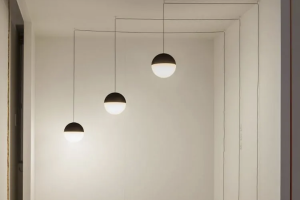Illuminate Your Garden with Stylish Lights

Garden lighting refers to the use of lights and fixtures to illuminate outdoor spaces, specifically gardens and landscapes. It involves strategically placing lights to enhance the beauty and functionality of the garden during nighttime. Garden lighting serves multiple purposes, including increasing safety and security, highlighting garden features, extending outdoor living space, and enhancing curb appeal. It can transform a dull and dark garden into a vibrant and inviting space.
Benefits of Illuminating Your Garden
1. Increased safety and security: One of the primary benefits of garden lighting is increased safety and security. Well-lit pathways and entrances can prevent accidents and deter potential intruders. By illuminating dark areas, you can ensure that your family and guests can navigate through the garden safely.
2. Highlighting garden features: Garden lighting allows you to showcase the beauty of your garden even after sunset. By strategically placing lights near trees, shrubs, or other focal points, you can create stunning visual effects and draw attention to specific areas or features in your garden.
3. Extending outdoor living space: With proper garden lighting, you can extend the usability of your outdoor space well into the evening. Whether you want to host a dinner party or simply relax in your garden after a long day, well-placed lights can create a warm and inviting atmosphere.
4. Enhancing curb appeal: Garden lighting can significantly enhance the curb appeal of your home. By highlighting architectural features or landscaping elements, you can create a visually appealing exterior that adds value to your property.
Types of Garden Lights
1. Path lights: Path lights are designed to illuminate walkways and pathways in your garden. They are typically low to the ground and provide a soft, diffused light that guides visitors safely through the garden.
2. Spotlights: Spotlights are used to highlight specific features or areas in your garden, such as trees, statues, or water features. They provide a focused beam of light that draws attention to the desired focal point.
3. Floodlights: Floodlights are powerful lights that emit a wide beam of light, ideal for illuminating large areas of your garden. They are commonly used for security purposes or to create a bright and well-lit outdoor space.
4. Deck and step lights: Deck and step lights are installed on decks, stairs, or pathways to provide visibility and prevent accidents. They are usually low-profile and emit a soft, downward light.
5. String lights: String lights are a popular choice for adding a whimsical and festive touch to your garden. They can be hung between trees, wrapped around pergolas, or draped along fences to create a warm and inviting ambiance.
6. Solar lights: Solar lights are an eco-friendly option that harnesses the power of the sun to illuminate your garden. They are easy to install and do not require any wiring or electricity.
Choosing the Right Garden Lights for Your Space
When choosing garden lights housetonlighting for your space, there are several factors to consider:
1. Size and style: Consider the size and style of your garden when selecting lights. Smaller gardens may benefit from subtle and understated lighting, while larger gardens can accommodate more dramatic and statement-making fixtures.
2. Energy efficiency: Opt for energy-efficient lighting options, such as LED lights, to minimize energy consumption and reduce your carbon footprint. LED lights are long-lasting and cost-effective in the long run.
3. Budget: Set a budget for your garden lighting project and prioritize your lighting needs accordingly. There are options available at various price points, so you can find lights that fit within your budget without compromising on quality.
4. Placement and installation: Plan the placement of your lights carefully to ensure optimal illumination and visual impact. Consider factors such as the direction of light, shadows, and potential obstructions. If you’re not confident in your electrical skills, it may be best to hire a professional for installation.
DIY Garden Lighting Ideas
If you’re feeling creative and want to add a personal touch to your garden lighting, here are some DIY ideas:
1. Mason jar lights: Repurpose mason jars by turning them into charming lanterns. Insert battery-operated LED lights into the jars and hang them from trees or place them on tables for a rustic and whimsical look.
2. Wine bottle lights: Empty wine bottles can be transformed into elegant outdoor lights. Insert string lights into the bottles and place them along pathways or on tables for a romantic and ambient glow.
3. Tin can lanterns: Create unique lanterns by punching holes in tin cans in various patterns. Place tea lights or LED candles inside the cans and hang them from tree branches or shepherd’s hooks for a magical effect.
4. DIY solar lights: Make your own solar lights by repurposing old glass jars or containers. Insert solar-powered LED lights into the jars and place them in sunny spots in your garden for an eco-friendly lighting solution.
Safety Considerations for Garden Lighting

While garden lighting can enhance the beauty and functionality of your outdoor space, it’s important to prioritize safety:
1. Proper installation: Ensure that all lights are installed correctly and securely to prevent accidents or damage. Follow manufacturer instructions and consult a professional if needed.
2. Use of GFCI outlets: Install ground fault circuit interrupter (GFCI) outlets to protect against electrical shocks in wet areas, such as near water features or sprinkler systems.
3. Avoiding overloading circuits: Be mindful of the electrical load on your circuits to prevent overloading and potential fire hazards. Spread out the placement of your lights across multiple circuits if necessary.
4. Regular maintenance and inspections: Regularly inspect your garden lights for any signs of damage or wear. Replace faulty bulbs or fixtures promptly to maintain optimal safety and performance.
Maintenance and Care for Garden Lights
To ensure the longevity and performance of your garden lights, regular maintenance and care are essential:
1. Cleaning and upkeep: Clean your lights regularly to remove dirt, debris, and any buildup that may affect their performance. Use a soft cloth or brush to gently wipe away any residue.
2. Replacing bulbs and batteries: Check the bulbs and batteries in your lights periodically and replace them as needed. This will ensure that your lights continue to provide optimal illumination.
3. Winterizing outdoor lighting: Before winter arrives, take steps to protect your outdoor lighting from harsh weather conditions. Remove any lights that are not designed for winter use and store them indoors until spring.
Enhancing Your Garden with Colorful Lights
If you want to add a pop of color to your garden, consider incorporating colorful lights:
1. Using colored bulbs: Replace standard white bulbs with colored bulbs to create a vibrant and festive atmosphere. Choose colors that complement your garden’s aesthetic or match the theme of a special event.
2. Incorporating color-changing lights: Opt for color-changing LED lights that can cycle through a variety of colors. This allows you to create different moods and effects depending on the occasion or your personal preference.
3. Creating a themed garden with colored lights: Use colored lights strategically to create a themed garden. For example, blue lights can evoke a tranquil and serene ambiance, while red lights can create a romantic and passionate atmosphere.
Creating a Cozy Ambiance with Garden Lights
To create a cozy and inviting ambiance in your garden, consider the following tips:
1. Softening harsh lighting: Use diffusers or frosted bulbs to soften the intensity of your garden lights. This will create a more gentle and inviting glow.
2. Using warm-toned bulbs: Opt for warm-toned bulbs, such as those with a yellow or amber hue, to create a cozy and intimate atmosphere. These bulbs mimic the warm glow of candlelight and can make your garden feel more welcoming.
3. Adding dimmer switches: Install dimmer switches for your garden lights to have control over the brightness levels. This allows you to adjust the lighting according to the mood or activity taking place in your garden.
Transform Your Garden with Beautiful Lighting
In conclusion, garden lighting is a versatile and essential element in creating a beautiful and functional outdoor space. It offers numerous benefits, including increased safety and security, highlighting garden features, extending outdoor living space, and enhancing curb appeal. By choosing the right types of lights for your space, considering factors such as size, style, energy efficiency, budget, and placement, you can transform your garden into a stunning oasis.
Don’t be afraid to get creative with DIY lighting ideas or incorporate colorful lights to add a personal touch and create a unique ambiance. Remember to prioritize safety by ensuring proper installation, using GFCI outlets, avoiding overloading circuits, and conducting regular maintenance and inspections. With the right lighting choices and care, you can truly transform your garden into a magical and inviting space that can be enjoyed day and night.





